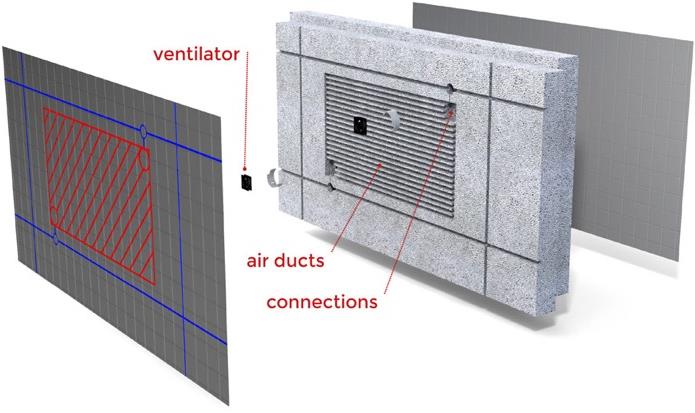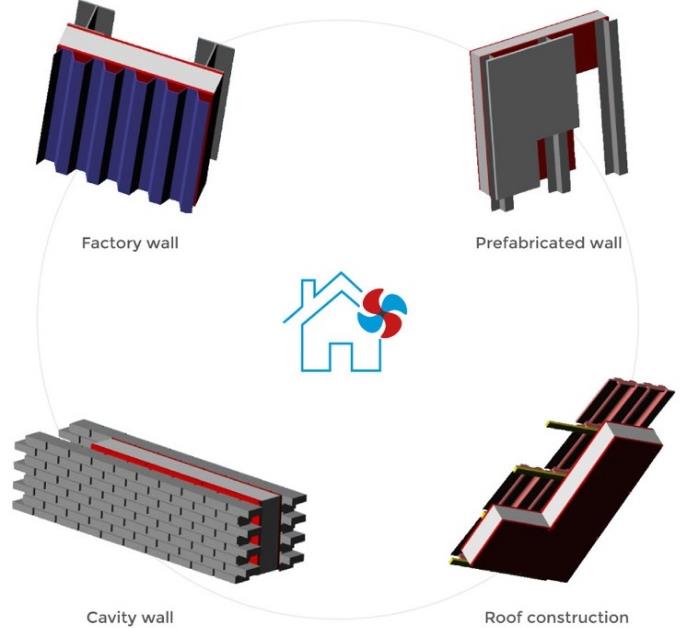Solar Gains Control Systems
Prototype Systems
Active Insulation
By Roel Loonen, Eindhoven University of Technology, The Netherlands
Product Description
Brief Concept Description
Active Insulation is a building envelope system developed by the Dutch start-up “Active Insulation Systems BV” whose insulation function can be switched on and off. During normal operation, the building skin acts as a regular thermal barrier between indoor and outdoor. In some occasions, however, the heat transfer can be encouraged instead of blocked to exploit the external climatic conditions to reduce the energy load of the building and improve the comfort of the occupants. During summer nights, for example, it is possible to take advantage of the lower outdoor air temperature to regulate the indoor temperature without active cooling. Similarly, the thermal insulation can be bypassed during sunny days in winter, to make better use of solar gains and reduce the space heating demand.
The current prototype is based on already proven technologies and functions as a closed-loop air-to-air heat exchanger as shown in Figure 66. Manifold channels are inscribed in the insulation material and small embedded fans (~0.5 W/m2) allow the occupant or the building management system to either create a stagnant air cavity, or to short-circuit the insulation layer by means of the airflow. Initial calculations indicate a heat exchange rate of ~15 W/m2 at a temperature difference of 10 C (on state). Hot-box simulations show a change of Rs value from 5.4 m2K/W (off state) to 0.6 m2K/W (on state), which can be further tuned depending on the host construction. Full-scale experimental studies and dynamic building performance simulations are currently being carried out.

Figure 66. Schematic drawing of Active Insulation.
Architectural and Technological Integration into the Envelope
Active Insulation is a standalone system (no air/water channels are entering or leaving the panel, Figure 67) that takes an existing insulation slab as its starting point. It is therefore fully compatible with existing ways of working in the construction industry.
Since the slabs are fitted with regular mounting points that do not interfere with the heat exchanging capability of Active Insulation, it can be integrated in many different construction types, such as masonry walls, prefabricated sandwich wall elements, steel frame panels or (pitched) roof systems (Figure 68).

Figure 67. Vertical section of a wall integrating Active Insulation. The system works as a closed loop heat exchanger with no exchange of air or water with indoor and outdoor environments.

Figure 68. Different applications of Active insulation in a variety of construction typologies.
Integration into the Building: System and Comfort
The fans integrated in the Active Insulation panels need a small amount of electric power to operate (~0.5 W/m2), which can be supplied through a wired connection or by means of autonomous PV systems with battery storage.
To maximize the benefits of Active Insulation, it is important that the operation of the system is well coordinated. This is a challenging task that may need different approaches for different orientations and depends on the (expected) occupancy of the building. The development of advanced control strategies and coupling with the building management system are therefore necessary conditions for a successful application of Active Insulation.
SWOT Analysis
Strengths
- It is possible to enhance the indoor comfort during summer by releasing heat to exterior environment during night-time and reduce the space heating demand in winter exploiting solar heat gains
- The architectural design of the opaque façade parts is not influenced. There are no restrictions to the placement of the transparent façade parts
- The system is easy to understand and has only few moving parts
- It is usable for many types of facades and roofs, without increasing the thickness of the structure
- The additional investment of the system is lower in comparison with traditional insulation
- The product is easy-to-install and requires little extra effort compared to conventional insulation
- It is a prefabricated solution with modular dimensions
- There is no security risk compared to operable windows for night ventilation
- The system is very silent and can be applied in noisy urban environments where operable windows are not suited
- It is suitable in areas with high air pollution as night cooling is decoupled from fresh air supply
Weaknesses
- Fans are expected to have long lifetime (mature product from PC industry). However, in case of malfunctioning, replacement will be time consuming/impossible, depending on type of structure used
- Multiple sections of Active insulation can be controlled individually, but this requires multiple sensors for good control of system (indoor temperature per zone, outdoor surface temperature, indoor surface temperature)
- Control “intelligence” needs to be designed and implemented on a case-by-case basis
- The system requires buildings with a minimum daytime space heating demand to function optimal during the heating period
- External shadows on the opaque surface due to surroundings can influence performance during the heating period
- The integration of Active Insulation in existing buildings requires a significant retrofit. Purchasing of local air conditioning systems can also alleviate the overheating problem, has an immediate effect and is less cumbersome
Opportunity
- The currently used EPS could be replaced by biodegradable materials with similar properties to meet the requirements for ‘circular economy’
- The system is fully compatible with new building codes prescribing high thermal insulation values • Buildings with large closed facades where view is of minimal interest (e.g. theatres, industrial halls and garages) are an interesting application • The cooling effect during summer can in some cases eliminate the need of mechanical cooling systems and save the associated investments • A combination with BIPV could be studied to manage both energy generation and heat transfer control on opaque surfaces • Global warming results in more overheating during summer, increasing the demand for solutions like Active Insulation
Threats
- Other opaque or transparent adaptive insulation systems with higher potential could be developed in the future
- Condensation may occur due to the possibility of low interior surface temperatures
- The urban heat island effect reduces the effectiveness and duration of nocturnal cooling
- The system is invisible. Apart from being a strength, this is also a threat, because low awareness may lead to less willingness to invest
- It is hard to make a tangible business case around the value of improved summer comfort
- Active Insulation is not (yet) included in design support tools (e.g. BIM) and energy assessment methods (e.g. energy labels)
Lessons Learned
- The responsibility of summer overheating as a negative side-effect of (too) high thermal insulation is not clear. It is currently considered as a responsibility of neither the building designer, nor the HVAC specialist. This lack makes the integration of Active Insulation in the construction process not straightforward.
- The dynamic characteristics and physical phenomena that take place inside façades with Active Insulation are not compatible with typical algorithms in building performance simulation software. The prediction of the performance of Active Insulation therefore requires the modification of simulation models at the source code level. This is a time-consuming task that needs to be carried out by specialists.